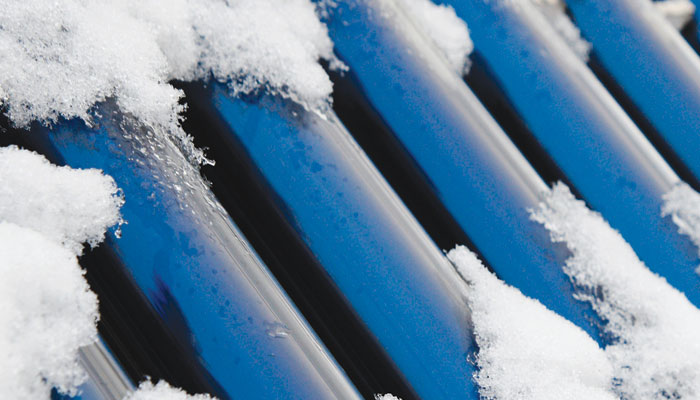Low-temperature in-floor hydronic systems have gained a higher profile, if not a higher market share, in North America over the years. There are champions and detractors; good systems and horrible systems. Every aspect of the house and the system has to be taken into consideration in the system design: heat load, envelope performance, available thermal mass, flow rates, delivery and return temperatures, friction/head loss, tube sizing and spacing, zoning, and controls. It’s like mastering a balancing act with a ball, a stick, two dogs and a running chainsaw.
The design challenge becomes more involved the further ‘above code’ a high-performance house gets, with the ultimate goal being Zero Net Energy (Zero Net Energy indicates that a house is designed to produce as much energy in a year as it consumes). When you ramp up the envelope and minimize the heating load, meeting the domestic hot water load becomes your priority.
A few of the considerations involved in designing a heating system of a high-performance or Zero Net Energy House in a cold climate include:
- The energy required to produce and deliver the space and water heating has to be minimized to control the size of the PV array.
- The capital cost of a more complex heating system has to be weighed against the capital cost of a larger PV array plus a simpler heating system that may require more purchased energy.
- Continuous duty energy trade offs (fan versus pump efficiency, for example) must balance out
- The flexibility and range of current and/or future energy sources that the system can plug into has to be considered.
Cooler Temps, Higher Efficiency
In a high-performance house, the temperature of the surfaces the occupants are exposed to are slightly higher – and fluctuate less with drops in outside temperatures – than those in typical construction. As a result, the flux (the amount of heat required to keep the living space comfortable) is reduced. In a hydronic system, this means the delivery temperature is also reduced, and the cooler the delivery temperature, the better the system efficiency in heating mode.
As an example, a ‘typical’ house in our climate (7,860 heating degree days; in Nova Scotia) could have R12 to R20 below-grade walls; R20 to R30 above-grade walls; R40 to R50 ceiling; double pane, low-e windows; and +4 air changes per hour (ACH@50Pa.) This typical house can have a flux of between 20 and 30 Btu/hour per square foot (SF). The delivery temperature could be anywhere from 89 to 102 °F.
For a high performance, or Zero Net Energy house in this climate, we are typically specifying R24± below-grade walls, R40 above-grade walls, R80 ceilings, triple-pane or suspended film windows with low-e, argon fill and insulating spacers, and less than 1.0 ACH@50Pa. The flux can be as low as 8 Btu/hr per SF, and the delivery temperature could be 77 to 80 °F.
By improving the building envelope dramatically as in our high-performance house specifications, you are, in essence ‘moving’ the indoor environment to a climatic zone with fewer heating degree days. This means there are effectively fewer days in the heating season.
On the face of it, a radiant heating system could be a good solution for a high-performance house in a cold climate. However, the low space-heating load makes it difficult to find a boiler with a small enough capacity to match the heating load. If the space heating and domestic hot water (DHW) are integrated, over-sizing is somewhat relieved when there is seasonal demand for both space and water heating, but the boiler is oversized when there are no space heating requirements. Depending on the fuel source and the efficiency of the boiler, short cycling through the non-heating season can result in an energy penalty that can affect the likelihood of the house functioning as a Zero Net Energy unit.
There is also a significant energy penalty for a low-temperature delivery system that uses a boiler. ‘Exergy’ describes the match between energy supply and energy demand. In most buildings, high temperature sources (boilers and furnaces) are used to meet low-temperature heating needs and have ‘high’ exergy. As high-performance houses transition into Zero Net Energy, the match between supply and demand temperatures makes a difference.
Design Challenges
If in-floor hydronics are to be a selling feature in high-performance houses or Zero Net Energy projects in cold climates – how do you design for such a miniscule load and low delivery temperatures, combine space and water heating and still make the system viable, both in terms of energy efficiency and cost effectiveness?
One way of meeting a high percentage of the DHW load is to use solar thermal as the primary heat source. Rooftop collectors gather heat from the sun; a heat exchange mechanism transfers the heat to a DHW storage tank for use on demand at the tap. An auxiliary heat source backs up the solar.
There is a great match between solar thermal and hydronics, in terms of exergy. Solar thermal can easily produce heating and cooling at temperatures close to the delivery temperature. Oversizing a solar DHW system so that it can meet some of the space heating requirements is one of our strategies if we can’t incorporate passive solar design into the house.
A typical two-unit flat plate collector system for a family of four can provide up to 70 percent of that annual DHW load in our climate. Initially, adding a collector or two to a standard solar DHW system looks like a reasonable way of getting a significant chunk of that small space-heating load. However, the heaviest space heating loads in cold climates happen in the less-than-solar-ideal months: the sun is lower in the sky, and above the horizon for fewer hours.
In addition, flat plate collectors don’t perform at peak capacity at low exterior temperatures. Evacuated tube collectors, on the other hand, can collect and retain heat even when its very cold outside, and typically have better performance in cloudy conditions.
While there is great debate about the efficiency and performance of the two different types of collectors, they both work, and they both have excellent characteristics for a variety of applications. Either type of collector can be mounted to favor winter production or summer production, or a year-round average.
Seasonal Variations
The biggest challenge in utilizing solar thermal for space heating is figuring out what to do with an oversized system in the summer, when hot water supply could be double or triple the demand. The hot tub as heat dump is not the solution for everyone.
One approach is to split two types of collectors into summer and winter configurations. A standard-issue 2-unit flat plate collector on the south-facing roof at an angle to provide a good year-round average provides DHW most of the year, while a bank of evacuated tubes, set at the angle best suited to deep-winter solar collection is mounted on a south-facing wall. Both sets of collectors feed back into the same storage tank. Controls manage DHW supply or space heating supply.
To effectively ‘shut off’ the evacuated tubes, they are mounted on a south facing wall with a deep overhang, so they are shaded out over the summer, early fall and late spring months. A high-performance house in Nova Scotia , with a flux of 8-10 Btu/hr per SF, requires heat from early November through March (a typical house here requires heat anywhere from mid-September through early May).
We do need an auxiliary water heater, slightly bigger than a typical household DHW source. The choice of energy source for the backup system is dependent on the client and the circumstance.
A limited amount of cooling can be provided by an in-floor system. In Nova Scotia, with our relatively mild and moist summers, the biggest issue is not cooling, but dehumidification. When massive cool objects, like concrete foundation walls and slabs, meet warm humid air in uncontrolled situations, the result is condensation. Keeping a radiant floor at 68°F or more eliminates the risk of condensation when the relative humidity is between 60 and 70 percent.
System Energy Use
For Zero Net Energy houses, the energy required to run the system will always be a top concern. For in-floor hydronics, the choice of circulator pumps is key. High-performance houses can maintain comfort levels with simpler zoning, so the number of circulators is reduced. High-efficiency, DC circulating pumps with ECM motors are commonly used in the PV world, where off-grid situations drive the need for continuous duty pumps that use very little energy. Variable speed versions of these pumps allow the whole system to be more finely tuned.
For example, one case study of an off-grid house in Colorado, where variable speed ECM circulators with a smart controller replaced three induction-type pumps, showed a reduction of 50 percent in energy consumed by the circulators. Monitoring before and after showed that the induction circulators had a constant draw on the PV system of 82W, while the replacement ECM circulators with variable speeds were drawing 27W at a 9gpm flow, and 9W at a 2gpm flow. That’s hugely significant when designing for Zero Net Energy.
There are many factors at play in designing a cold-climate high-performance house that could be ramped up to Zero Net Energy. We have found that an in-floor hydronic system matched with solar thermal is part of an overall strategy to reduce the size and cost of a PV array is one approach that our clients are comfortable with.





